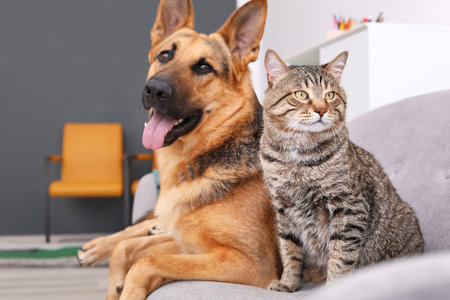Understanding Lease Agreements and Pet Policies
Before making any pet-proofing changes to your rental, it’s essential to review your lease agreement thoroughly. Many landlords include specific clauses related to pets, outlining rules, restrictions, and any potential fees or deposits required. Understanding these terms will help you avoid violations that could lead to penalties or even eviction.
Reviewing Your Lease Agreement
Start by looking for sections in your lease that mention pets. These may include:
- Pet deposits or additional rent fees
- Breed or size restrictions
- Rules regarding damage caused by pets
- Approved modifications for pet-proofing
Communicating with Your Landlord
If your lease agreement doesn’t clearly address pet-proofing modifications, reach out to your landlord for clarification. Discuss any temporary adjustments you plan to make and ensure they align with their policies. Some landlords may be open to minor changes as long as they don’t cause permanent damage.
Questions to Ask Your Landlord
| Topic | Questions to Ask |
|---|---|
| Allowed Modifications | Are removable pet gates or adhesive protectors permitted? |
| Security Deposit Impact | Will minor pet-related wear and tear affect my deposit? |
| Permanency of Changes | Can I use temporary floor coverings or wall protectors? |
| Alternative Solutions | Do you have recommendations for renter-friendly pet-proofing? |
Finding Compromises for Pet-Proofing
If your landlord has concerns about certain modifications, consider suggesting reversible solutions. For example:
- Using furniture pads instead of nailing scratch guards to walls
- Placing area rugs over carpeted areas to prevent stains
- Applying removable wall decals instead of painting or installing panels
Why This Matters
Understanding your lease agreement and openly communicating with your landlord can prevent potential disputes while allowing you to create a safe environment for your pet. By working within the rental rules, you can find creative ways to pet-proof without causing damage.
2. Floor Protection: Preventing Scratches and Stains
Keeping your rental’s floors in good condition is essential, especially when you have pets. Scratches, stains, and general wear can be difficult to fix and may lead to losing your security deposit. Fortunately, there are easy ways to protect your floors without causing any permanent damage.
Use Area Rugs and Carpet Runners
Placing area rugs or carpet runners in high-traffic areas helps prevent scratches from pet claws and minimizes stains from accidents or spills. Look for rugs with a non-slip backing to keep them securely in place, reducing the risk of slips for both you and your pet.
Temporary Floor Mats
If you want additional protection, consider using temporary floor mats, especially in areas where your pet spends the most time. These mats are easy to clean and can prevent dirt, moisture, and pet hair from settling into carpets or hardwood floors.
Pet-Friendly Furniture Covers
Your pet’s favorite lounging spots can contribute to floor wear as they jump on and off furniture. Using pet-friendly furniture covers or washable slipcovers helps reduce fur buildup and accidental messes while also protecting the furniture itself.
Comparison of Floor Protection Options
| Protection Method | Benefits | Best For |
|---|---|---|
| Area Rugs & Carpet Runners | Cushions impact, prevents scratches, adds style | Hardwood floors, tile, high-traffic areas |
| Temporary Floor Mats | Easy to clean, protects against spills & dirt | Kitchens, entryways, feeding areas |
| Pet-Friendly Furniture Covers | Keeps fur off furniture, reduces wear on flooring | Sofas, chairs, beds with frequent pet use |

3. Wall and Door Protection: Preventing Claw Marks and Chewing
Pets, especially cats and dogs, can sometimes scratch walls or chew on doors, leading to unwanted damage in a rental home. Since making permanent changes isnt an option for renters, using temporary protective solutions can help keep the property intact while ensuring your pet has a safe environment.
Use Removable Wall Protectors
One of the easiest ways to prevent claw marks on walls is by applying removable wall protectors. These are clear adhesive sheets or plastic panels that stick to walls without leaving residue when removed. Theyre especially useful in areas where pets tend to scratch, such as near feeding stations or entryways.
Install Scratch-Resistant Panels Around Doors
If your pet tends to scratch doors, consider installing temporary scratch-resistant panels. These panels attach with non-damaging adhesives or hooks and can be easily removed when you move out. They provide a sturdy barrier against claw marks while keeping the door surface intact.
Use Temporary Gates to Limit Access
Placing temporary gates in front of certain rooms or entryways can help prevent pets from reaching areas they might damage. This is particularly useful for puppies who are still learning boundaries or cats that enjoy scratching door frames.
Comparison of Temporary Protection Options
| Protection Method | Best For | Installation Type | Removability |
|---|---|---|---|
| Removable Wall Protectors | Cats and dogs that scratch walls | Adhesive sheets or plastic panels | Easily removable without residue |
| Scratch-Resistant Door Panels | Pets that scratch doors | Tape, hooks, or suction cups | No permanent damage upon removal |
| Temporary Gates | Puppies or pets needing restricted access | Tension-mounted or freestanding | No installation required, easy to move |
Create Alternative Scratching Spots
If your pet scratches out of habit or boredom, redirect their behavior by providing designated scratching posts or pads near the areas they usually target. Using cat-friendly furniture covers and deterrent sprays can also help reduce unwanted scratching.
Avoid Harsh Punishments
Punishing your pet for scratching or chewing may lead to stress and anxiety. Instead, use positive reinforcement techniques like treats and praise when they use designated scratching areas. Training combined with protective barriers will help maintain both your rental home and your pet’s happiness.
4. Managing Pet Odors and Minimizing Fur Spread
Keeping your rental home fresh and free of pet odors and fur can be a challenge, but with the right strategies, you can maintain a clean and welcoming space without causing damage to the property.
Invest in Air Purifiers and Odor-Neutralizing Sprays
Air purifiers with HEPA filters help remove pet dander, fur, and odors from the air, making your home smell fresher while also improving air quality. Odor-neutralizing sprays specifically designed for pet-friendly homes can also help eliminate lingering smells without leaving behind harsh chemical residues.
Choose Washable Pet Beds and Covers
Opt for pet beds with removable, washable covers to prevent odors from building up over time. Regularly washing these covers will keep your space smelling clean while also reducing allergens. Additionally, using washable furniture covers or blankets on couches and chairs can help protect upholstery from fur accumulation.
Regular Grooming to Reduce Shedding
Frequent brushing and grooming can significantly minimize loose fur around your home. Depending on your pet’s breed, brushing daily or several times a week can prevent excessive shedding. Bathing your pet regularly with a mild shampoo also helps reduce dander and odor.
Vacuuming and Cleaning Routine
A consistent cleaning schedule is key to managing fur and odors. Using a vacuum with a pet hair attachment can effectively remove fur from carpets, rugs, and furniture. Consider a robotic vacuum for daily maintenance if shedding is a major concern.
Recommended Cleaning Tools
| Cleaning Tool | Purpose |
|---|---|
| HEPA Air Purifier | Removes pet dander and odors from the air |
| Odor-Neutralizing Spray | Eliminates lingering pet smells |
| Washable Pet Bed Covers | Keeps bedding fresh and odor-free |
| Pet Hair Vacuum Attachment | Effectively removes fur from furniture and carpets |
| Lint Roller | Quick removal of hair from clothing and surfaces |
Using Natural Deodorizers
Baking soda is an excellent natural deodorizer that can be sprinkled on carpets before vacuuming to absorb pet odors. Activated charcoal bags are another great option for absorbing unwanted smells without using synthetic fragrances.
Litter Box Maintenance for Cat Owners
If you have a cat, maintaining the litter box is essential to controlling odors. Scooping daily, changing the litter regularly, and using an enclosed or high-quality odor-control litter box can make a big difference in keeping your home smelling fresh.
By following these simple steps, renters can effectively manage pet odors and fur buildup without making permanent changes to their living space.
5. Safe and Temporary Training Solutions
Training your pet while renting can be a challenge, especially when you need to avoid permanent modifications to the space. Fortunately, there are temporary solutions that help create a controlled environment without causing damage to your rental property.
Utilize Portable Playpens
Portable playpens are an excellent way to provide a safe space for your pet without making permanent changes. These enclosures can be used indoors or outdoors, and they come in various sizes to accommodate different pets.
Use Non-Permanent Barriers
Non-permanent barriers, such as baby gates and freestanding pet gates, can help restrict access to certain areas of your home. They are easy to install and remove without damaging walls or door frames.
Adhesive-Free Training Pads
If youre house-training a pet, adhesive-free training pads are a great option. Unlike traditional pads with sticky backing, these can be placed on the floor without leaving residue or damaging surfaces.
Comparison of Temporary Training Tools
| Training Tool | Benefits | Best For |
|---|---|---|
| Portable Playpen | Create a designated area for pets; easy to move and store | Puppies, small dogs, rabbits |
| Non-Permanent Barriers | Keeps pets out of restricted areas; no installation required | Cats, dogs of all sizes |
| Adhesive-Free Training Pads | Avoids damage to floors; helps with house training | Puppies, senior dogs |
The Power of Positive Reinforcement
Apart from physical barriers, using positive reinforcement is key in training your pet effectively. Rewarding good behavior with treats, praise, or toys encourages them to follow rules without needing permanent adjustments to your living space.
6. Restoring the Rental Before Moving Out
When its time to move out, restoring your rental to its original condition is essential to ensure you get your security deposit back and leave on good terms with your landlord. Here are some steps to help you remove pet-proofing modifications without causing damage.
Repair Minor Damages
If youve used removable hooks, temporary barriers, or other pet-proofing solutions, carefully take them down. For small holes left by wall hooks or nails, use spackling paste and touch-up paint that matches the wall color. If youre unsure about paint color, check with your landlord for an approved option.
Deep Clean Carpets and Floors
Pets can leave behind fur, odors, and stains. To restore the flooring:
- Vacuum carpets thoroughly and consider using a carpet cleaner for deep stains.
- Sweep and mop hard floors to remove pet hair and dirt buildup.
- If there are scratches on hardwood floors, use a wood marker or polish to minimize their appearance.
Furniture and Wall Cleaning
Your pet may have left marks on walls or furniture. Use mild soap and water to wipe down scuff marks on walls. For fabric-covered furniture, vacuum any pet hair and use a lint roller for extra cleaning.
Checklist for Restoring Your Rental
| Task | Description |
|---|---|
| Patching Holes | Use spackling paste for small holes; sand and paint if necessary. |
| Cleaning Carpets | Vacuum thoroughly; shampoo carpets if needed. |
| Mopping Floors | Sweep and mop hard surfaces; repair minor scratches. |
| Removing Pet Hair | Vacuum furniture and use lint rollers for deep cleaning. |
| Touching Up Walls | Clean scuffs with soapy water; repaint if needed. |
Taking the time to properly restore your rental ensures that you leave the space in great condition, helping you secure a positive reference from your landlord when moving to your next home.


